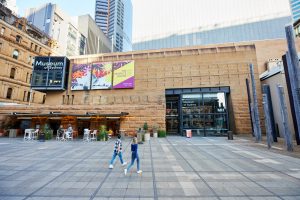With the current demolition of the Sydney Harbour Control Tower and the threat to sell off and destroy the Sirius building in the Rocks, we are constantly reminded of just how quickly the Sydney skyline changes and has changed in the past.
The Museum of Sydney’s newest exhibition, Demolished Sydney, remembers a variety of Sydney’s lost buildings, surveying some of the most significant demolitions of the past two hundred years.
We were lucky enough to grab some time with the curator, Nicola Teffer to find out more.
The exhibition reflects on how demolition has, at times, made way for the city’s most iconic buildings: the Fort Macquarie Tram Shed would be replaced by the world-famous Sydney Opera House, while the convict-era Commissariat Buildings would allow for a modernised Circular Quay. It also looks at the demolitions that signalled the end of eras and the beginning of others: both the Pyrmont Incinerator (demolished 1992) and the Kent (Carlton United) Brewery (demolished 2008) were demolished as industry moved out of the city fringes and people moved back in, while the demolitions of the Hotel Australia and Rowe Street in 1971-2 were part of a CBD office boom that spelled the demise of the once vibrant nightlife in this part of town.
Demolished Sydney explores how Sydney’s buildings have risen and fallen as technologies have changed, populations moved and industries diversified. Some buildings, like tram sheds and cinemas, were made obsolete by cars and television, while others were felled for city improvements, land values, environmental legislation or demand for housing and offices. Some demolitions have sharpened an appreciation of Sydney’s built heritage and led to a push for its preservation.
Demolished Sydney is on at the Museum of Sydney until 17 April 2017.




